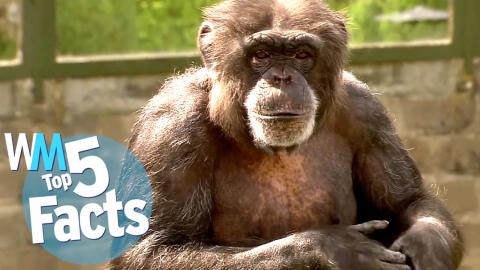Top 5 Weird & Wild Chimpanzee Facts

Who doesn't love chimps? (Well, besides the humans in Planet of the Apes...) Chimpanzees are a fascinating species, and studying them like Jane Goodall did might just give us a window into our own evolution. In this episode of WatchMojo's Top 5 Facts: some of the latest chimpanzee research, weird chimp diet facts, and you'll also see chimps' sexy cousins, the bonobo.
Special thanks to our user speechjon for submitting the idea on our Interactive Suggestion Tool at http://www.WatchMojo.comsuggest
https://www.youtube.com/watch?v=Fee9XSSPR4Y
Top 5 Facts About Chimpanzees
Chimpanzees are a fascinating species, and studying their complex behavior might just give us a window into our own evolution. Welcome to WatchMojo’s Top 5 Facts. In this installment, we’re counting down the most interesting facts that you probably didn’t know about one of the species of great ape, the chimpanzee.
#5: Chimp Travel Spurs Innovation
Sure, for human beings going to college is great, but it’s really that semester you take off to backpack in Eastern Europe that really teaches you about life, and really figure things out, you know? According to a 2016 study by one Dr. Gruber from the University of Geneva, travel also helps chimps figure things out. Specifically, it helps them become proficient in building their own tools. Gruber figures that the more energy they spend travelling, the more fuel they need, and so they more creative they get at accessing hard-to-reach food sources by innovating tools. In one experiment well-travelled chimps used some folded leaves as sponges to get honey out of a hole, instead of just inefficiently using their fingers. Props to those chimps: three months volunteering on organic farms after college, and I’m still eating honey with my hands.
#4: The Chimp Mating Ritual Is Quick
Chimps don’t beat around the bush when they want to mate. Nor do they play around during the act itself. In fact, the mating process takes approximately 15 seconds, give or take, and chimps have even been known to eat during intercourse as well. The ritual is quick, extremely quick, as the male and females pick up physical signals and seal the deal with astonishing efficiency. In fact, chimpanzees can easily find a potential mate based on two basic patterns of behavior. The females display an unmistakable swelling, sometimes even presenting themselves to males up close and personal, and is it just me or do we spend a lot of time talking about animal sex on this series? Moving on.
#3: Chimps Eat Clay to Detoxify Their Bodies
In the Budongo forest of Uganda, chimpanzees eat and drink clay for one specific reason: better digestion. As noted in a 2015 report by The University of Oxford, the minerals in the clay help chimpanzees neutralize the tannins in their bodies after consuming leaves. Some use their hands to gather the clay, but their customized sponge leafs also provide them a more effective way to acquire even more minerals. For chimps, they can get minerals from decomposing swamp trees, but a clay diet works as well. The practice of consuming the earth is actually called “geophagy,” and humans typically resort to such a diet when living in poverty. But weirdly, bathing in mud is a luxurious spa treatment reserved for the wealthy.
#2: Chimps Prefer Cooperation to Competition
This revelation comes courtesy of researchers from Emory University and overturns what previous research seemed to indicate. In 2014 they demonstrated that in complex social settings, chimpanzees can spontaneously assist one another to achieve a shared goal. The chimps even set aside their pre-existing relationships and group social dynamics to work together in transporting food. In 2016, Emory published more research which supported these findings, and also found that chimps use a number of strategies to discourage competition and freeloading. Scientific literature often says that human cooperation is unique, but this study’s authors say that chimps have shown us that’s just not true.
#1: Chimpanzee Wars Are Not Caused by Human Influence
Jane Goodall originally documented chimp on chimp violence in the 1970s, shocking the world with stories of chimpanzee communities waging war on each other. Many in the scientific community thought that human intervention– specifically, feeding the chimps and destroying their habitats– were what sparked these wars. But a 2014 analysis of fifty years of chimp research argued that the conflicts actually stem from an “adaptive fitness strategy.” Meaning them monkeys are just tryin’ to get in shape. No, actually, that’s fitness as in “survival of the fittest;” the apes are using violence to get more food and territory. I guess cooperating isn’t their only strategy.
So, are you more surprised by chimps’ levels of violence, or of cooperation? For more highly evolved top 10s and spilled-honey-on-my-knees Top 5s, be sure to subscribe to WatchMojo.com

